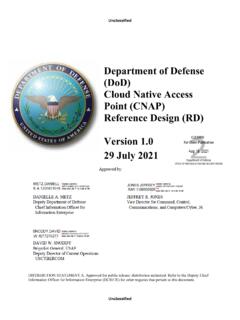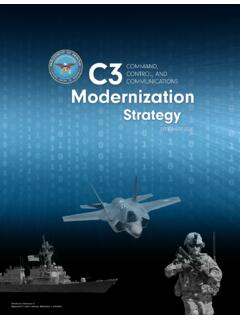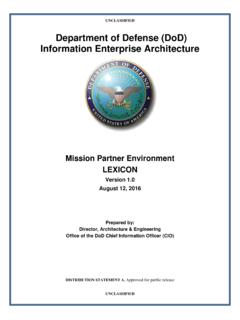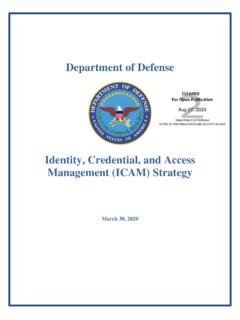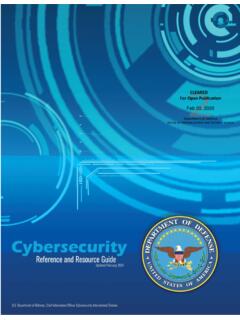Transcription of DoD Enterprise Identity, Credential, and Access Management ...
1 UNCLASSIFIED. DoD Enterprise Identity, Credential, and Access Management (ICAM). Reference Design CLEARED AS AMENDED. For Open Publication Aug 07, 2020. Version Department of Defense June 2020 OFFICE OF PREPUBLICATION AND SECURITY REVIEW. Prepared by Department of Defense, Office of the Chief Information Officer (DoD CIO). DISTRIBUTION STATEMENT C. Distribution authorized to Government agencies and their contractors (Administrative or Operational Use). Other requests for this document shall be referred to the DCIO-CS. UNCLASSIFIED. UNCLASSIFIED. Document Approvals Prepared By: Digitally signed by 38960 Date: 11:22:39 -04'00'. N. Thomas Lam IE/Architecture and Engineering Department of Defense, Office of the Chief Information Officer (DoD CIO). Digitally signed by 022639923 Date: 11:29:55 -04'00'.
2 Thomas J Clancy, COL US Army CS/Architecture and Capability Oversight, DoD ICAM Lead Department of Defense, Office of the Chief Information Officer (DoD CIO). Approved By: Digitally signed by 84616665 Date: 17:25:42 -04'00'. Peter T. Ranks Deputy Chief Information Officer for Information Enterprise (DCIO IE). Department of Defense, Office of the Chief Information Officer (DoD CIO). Digitally signed by Date: 11:07:35 -04'00'. John (Jack) W. Wilmer III. Deputy Chief Information Officer for Cyber Security (DCIO CS). Department of Defense, Office of the Chief Information Officer (DoD CIO). ii UNCLASSIFIED. UNCLASSIFIED. Version History Version Date Approved By Summary of Changes TBD TBD Renames and replaces the IdAM Portfolio Description dated August 2015 and the IdAM. Reference Architecture dated April 2014.
3 (Existing IdAM SDs and TADs will remain valid until updated versions are established.). Updates name from Identity and Access Management (IdAM) to Identity, Credential, and Access Management (ICAM) to align with Federal government terminology Removes and cancels the list of formal ICAM. related requirements Restructures document for clarity Updates ICAM Taxonomy to better conform to Federal ICAM Architecture Updates descriptions and data flows of ICAM. capabilities Summarizes current DoD Enterprise ICAM. services Defines ICAM roles and responsibilities iii UNCLASSIFIED. UNCLASSIFIED. Executive Summary The purpose of this Identity, Credential, and Access Management (ICAM) Reference Design (RD) is to provide a high-level description of ICAM from a capability perspective, including transformational goals for ICAM in accordance with the Department of Defense (DoD) Digital Modernization Strategy.
4 As described in Goal 3, Objective 2 of the DoD Digital Modernization Strategy, ICAM creates a secure and trusted environment where any user can Access all authorized resources (including [services, information systems], and data) to have a successful mission, while also letting the Department of Defense (DoD) know who is on the network at any given time. This objective focuses on managing Access to DoD resources while balancing the responsibility to share with the need to protect. ICAM is not a single process or technology, but is a complex set of systems and services that operate under varying policies and organizations. There are significant advantages to the DoD in providing ICAM services at the DoD Enterprise level, including consistency in how services are implemented, improved security, cost savings, and attribution by having a discrete defined digital identity for a single entity.
5 ICAM is also fundamental for the transformation to a modern data-centric identity-based Access Management architecture that is required in a future-state Zero Trust (ZT) Architecture. To gain these advantages, DoD Enterprise ICAM. services must support functionality for both the DoD internal community and DoD mission partners, must provide interfaces that are usable by Component information systems, and must minimize or eliminate gaps in supporting ICAM capabilities. The ICAM RD promotes centralization of identity and credential Management , including attribute Management and credential issuance and revocation. The ICAM RD also establishes standardized processes and protocols for authentication and authorization. Access decisions must be fundamentally managed by local administrators who understand the context and mission relevance for person entities and Non-Person Entities (NPE) who require Access to resources.
6 The RD defines an ICAM taxonomy that is based on the core elements of the Federal ICAM (FICAM). Architecture, and describes data flow patterns for each of the capabilities defined in the ICAM. taxonomy. Systems and services shown in these data flows may be operated at the DoD Enterprise , DoD. Component, Community of Interest (COI), or local level. In addition to generic data flow patterns, the RD. provides a set of implementation patterns and their related use cases for ICAM capabilities. These patterns are intended to demonstrate how capabilities may be implemented to meet a broad set of mission and other needs. They are not intended to be prescriptive for how a given information system consumes ICAM capabilities, nor are they intended to describe all possible ICAM use cases.
7 Finally, the RD describes existing and planned DoD Enterprise ICAM services, and roles and responsibilities for ICAM. service providers and for DoD Components in deploying ICAM. This document is not intended to mandate specific technologies, processes, or procedures. Instead, it is intended to: Aid mission owners in understanding ICAM requirements and describing current and planned DoD Enterprise ICAM services to enable them to make decisions ICAM implementation so that it meets the needs of the mission, including enabling authorized Access by mission partners. Support the owners and operators of DoD Enterprise ICAM services so that these services can effectively interface with each other to support ICAM capabilities. iv UNCLASSIFIED. UNCLASSIFIED. Support DoD Components in understanding how to consume DoD Enterprise ICAM services and how to operate DoD Component, COI, or local level ICAM services when DoD Enterprise services do not meet mission needs.
8 Each mission owner is responsible for ensuring ICAM is implemented in a secure manner consistent with mission requirements. Conducting operational, threat representative cybersecurity testing as part of ICAM implementation efforts is a mechanism that needs to be used to check secure implementation. v UNCLASSIFIED. UNCLASSIFIED. Contents 1. Introduction ..1. Purpose .. 2. Applicability .. 3. DoD Community .. 4. DoD Internal Community .. 4. External Mission Partner Community .. 5. Beneficiaries .. 5. Other Entities .. 6. DoD Computing Environment .. 6. References .. 6. 2. ICAM Capability Overview ..9. Transformational Goals .. 10. ICAM Capability Taxonomy Overview (DoDAF CV-2) .. 11. Core ICAM 12. Identity Management .. 13. Credential Management .. 16. Access Management .
9 19. Access Accountability Capabilities .. 23. Log Collection and 23. Access Review .. 24. Identity Resolution .. 25. Contact Data Capabilities .. 25. Contact Data Collection .. 26. Contact Data 26. Using DoD Enterprise ICAM Services .. 26. DoD Enterprise Benefits from Use of DoD Enterprise ICAM Services .. 26. Information System Benefits from Using DoD Enterprise ICAM Services .. 27. Mitigating Challenges to Using DoD Enterprise ICAM Services .. 27. 3. ICAM Data Flows .. 29. Core ICAM Capabilities .. 32. Identity Management .. 32. Person Entity .. 33. NPE .. 35. Federated 35. Credential Management .. 36. Internal Credential Management .. 36. External Credential Registration .. 38. Access Management .. 39. vi UNCLASSIFIED. UNCLASSIFIED. Resource Access Management .. 39.
10 Provisioning .. 40. Authentication .. 42. Authorization .. 45. Access Accountability Capabilities .. 47. Log Collection and 47. Access Review .. 48. Identity Resolution .. 49. Contact Data Capabilities .. 50. 4. ICAM Patterns and Associated Use Cases .. 51. Identity and Credential Patterns .. 51. Unclassified Enterprise DoD Internal Initial 51. Unclassified Enterprise Mission Partner Entity Registration .. 53. Community of Interest User Registration .. 54. Community of Interest Person Entity Identity Provider Registration .. 56. Secret Enterprise Registration for DoD and Federal Agencies .. 57. Secret Enterprise Registration for Non-Federal Agency Mission Partner Entities .. 58. Short-Lived NPE Registration .. 59. DoD Beneficiary Registration .. 60. DoD Applicant Registration.

